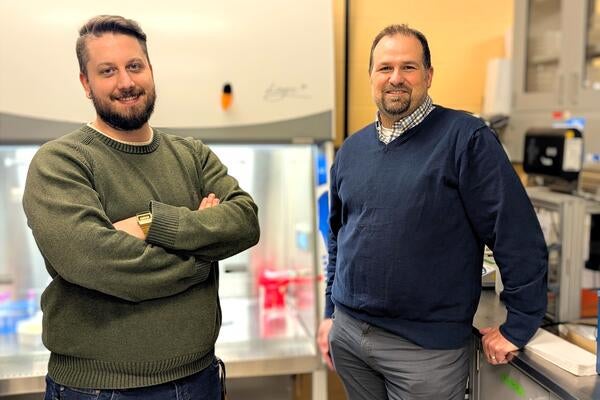
Moving biomedical research forward with IRONSperm
Sperm-templated soft magnetic microrobots offer promise for treating cancer, infertility and more

Sperm-templated soft magnetic microrobots offer promise for treating cancer, infertility and more
By Janet Armstrong Faculty of EngineeringHow would the treatment experience and outcomes change for cancer patients if we could actively deliver chemotherapy drugs directly to their tumours?
What if large and complex kidney stones could be dissolved without the need for invasive procedures?
Would the success rate of fertility treatments increase if specialists could guide live sperm directly to the most advantageous location for fertilization?
The answer to these and other questions may very well lie in medical microrobots. They also happen to be questions Dr. Veronika Magdanz, an assistant professor in systems design engineering at the University of Waterloo, is busy researching.
Magdanz’s work focuses on biomedical engineering – she’s always been inspired by biological applications in science. But her introduction to microrobotics happened quite by accident when she was searching for PhD opportunities.
“I saw a posting at the Leibniz Institute for Solid State and Materials Research in Germany,” Magdanz says. “They were basically looking for new ways to power microrobots. I knew nothing about the field but it sounded exciting!’”
Magdanz joined the team at the Leibniz Institute to work on different ways to fabricate nanostructures and microstructures. They developed microrobots made from platinum and iron that could move rapidly thanks to catalytic reactions fueled by hydrogen peroxide.
The team even earned their place in the Guinness Book of Records for making the smallest microjet engine in the world, measuring just a few hundred nanometers. To put that in perspective, that’s approximately 100 times smaller than the radius of a human hair.
 Dr. Veronika Magdanz, a Waterloo Engineering professor, has developed microrobots that can be controlled magnetically for various medical, environmental and manufacturing applications.
Dr. Veronika Magdanz, a Waterloo Engineering professor, has developed microrobots that can be controlled magnetically for various medical, environmental and manufacturing applications.
Despite their record-setting diminutiveness, those microrobots lacked biocompatibility due to their hydrogen peroxide fuel source. This made them poor candidates for biomedical applications.
So Magdanz began researching solutions that would be more friendly to living tissue.
To her surprise, that solution turned out to be sperm cells. Why sperm? The answer is simple – movement.
“The flexibility that sperm possess is hard to fabricate because they have one part that is stiffer and one part that’s a bit more flexible,” says Magdanz. “But they move really well which has applications for drug delivery and cargo delivery in general.”
Magdanz got to work uniting bovine sperm with microtubes and found that the sperm could effectively move the microtubes around. This discovery laid the groundwork for the creation of IRONSperm.
The rise of IRONSperm
IRONSperm may sound like a biological superhero, but it turns out the name is aptly descriptive. Since live bovine sperm can’t be injected into humans to deliver cargo such as cancer-fighting drugs, the microrobots are constructed using deactivated bovine sperm that are coated with magnetic nanoparticles. The non-motile sperm cells serve as a flexible template and drug carrier that researchers control movement of using external magnetic fields. Since the IRONSperm are magnetized, they can also be seen on ultrasound.
The sperm themselves don’t always need to be magnetized. Magdanz describes a potential application for combining live human sperm with magnetized microtubes to treat infertility. Once they are securely in the microtubes, the sperm can theoretically be guided using external magnets to an optimal location for fertilization.
Sometimes sperm aren’t involved at all. Magdanz is also studying the application of artificial microrobots made from magnetized gelatin-based flexible filaments to treat large kidney stones non-invasively.
“The idea would be to load them with drugs, inject them with a catheter into the bladder or in the kidney and then leave them there for a few days to help dissolve the kidney stone faster,” she says.
By 3-D printing organ models in the lab, Magdanz and team can test both the microrobots and the magnetic control system. This work is currently being funded by the Graham Seed Fund from the University of Waterloo’s Centre for Bioengineering and Biotechnology (CBB).
Miniscule size, massive potential
Medical treatments aren’t the only areas where the application of microrobots hold great promise. Their tiny stature allows them easy entry into typically inaccessible locations, making them perfect for environmental applications like sensing pollutants in sea water. They can also be used in fabrication and automation to help with tasks like remote parts assembly.
Although she’s only been at Waterloo for eight months, Magdanz claims she’s already benefitted greatly from the open-minded and highly collaborative environment. She plans to continue collaborating with other researchers and medical professionals around the world and across the Waterloo campus to explore different applications of medical microrobotics.
“My brother was diagnosed with leukemia when he was just four years old. Seeing how badly the side effects of traditional chemotherapy impacted him made me realize that we need to find better ways to treat cancer,” Magdanz says. “Even if my work makes a tiny difference in people’s lives one day, I’ll be happy.”
Dr. Veronika Magdanz is co-organizing SOMMeRS 2023: Southern Ontario Medical MicroRobotics Symposium in partnership with Dr. Hamed Shahsavan, an assistant professor in chemical engineering at Waterloo. This free event is taking place on the Waterloo campus between 8:30 a.m. and 6:00 p.m. on Tuesday July 11, 2023. Registration is open to anyone who is interested in the growing multidisciplinary field of medical microrobotics.

Read more
Here are the people and events behind some of this year’s most compelling Waterloo stories

Engineering master's student Nayeema Nonta (left), one of the three paper authors, and her supervisor, Dr. Sirisha Rambhatla, in a large server room with the computer power needed to develop their new LLM training technique. (University of Waterloo)
Read more
Waterloo researchers develop highly efficient AI training system that paves the way for cheaper, greener “intelligent partners”

Read more
Engineering researchers team up to tackle the plastics pollution problem with microbial innovation and engineering design
The University of Waterloo acknowledges that much of our work takes place on the traditional territory of the Neutral, Anishinaabeg, and Haudenosaunee peoples. Our main campus is situated on the Haldimand Tract, the land granted to the Six Nations that includes six miles on each side of the Grand River. Our active work toward reconciliation takes place across our campuses through research, learning, teaching, and community building, and is co-ordinated within the Office of Indigenous Relations.